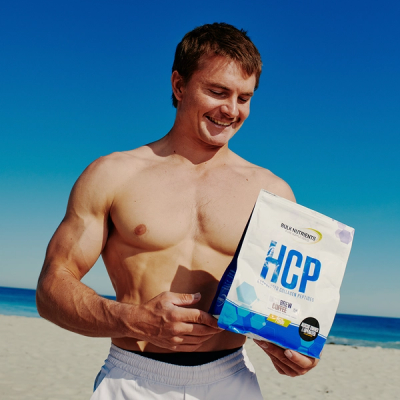
Does Bovine Collagen Assist in Muscle Growth?
Posted by Bulk Nutrients
Estimated reading time: 5 minutes

We've spoken many times on this blog about the three principles of muscle growth, that should be on the walls of every gym:
And pertaining to these principles, whilst not mentioned directly, is progressive overload.
And progressive overload is important because it directly drives muscle growth.
So, what is it exactly?
It's simply increasing the workload for muscles beyond present capacity.
And this is what induces further muscle growth.
Research shows we can practice progressive overload in the following four ways:
Research tells us the most popular method is number 1.
And this falls in line with the first principle of muscle growth, mechanical tension; the tension a muscle is under in response to the load being lifted.
In other words, lifting heavy induces more mechanical tension.

Progressive overload should be slowly implemented into your program.
But how slowly?
Well, research suggests that changes in total training volume (reps, sets, load) be made in increments of 2.5% to 5.0% per week to avoid the chance of overtraining.
Now whilst this all seems like common sense, no one at the gym is really doing it!
It's not uncommon to see certain gym-goers do the same volume and weight, week in and week out.
This is why most people's physiques never change.
In order for muscle to keep growing, it must be tested beyond what it is used to.
The same principle applies to most things in life; we don't get better by doing what we've always done!
Specifically, as muscles become more capable of producing greater force, power or endurance, it's time to increase the workload.
Because without these forced measures, muscle adaptations (like growth) can't occur.
And if we chose to not adapt, then we will hit a plateau.
But it's a balancing act; we must continue to lift weights with enough frequency, weight, and time, to allow for progressive overload to occur without producing fatigue.
Of course, adding more weight to the bar leads to an increase in strength, which is partially due to an increase in muscle size.
But this isn't the only way to grow muscle, of course. Lighter loads help, too.

Progressive overload can still be achieved with a lighter weight. Specifically, via the aforementioned strategy number 2: increasing the number of reps (still with a lighter weight), sets, or exercises performed.
Whilst we need to incorporate heavier weight as one strategy for progressive overload as discussed, higher reps cannot and should not be discounted.
This study had two groups of untrained subjects perform leg extensions at 30 per cent of their one-rep max, or at 80 per cent. And there was no difference in muscle growth!
Another review into rep ranges and muscle growth examined studies that had subjects perform at less than 60 per cent of their one-rep max, and more than 60 per cent. They concluded:
"...muscle hypertrophy can be equally achieved across a spectrum of rep ranges."
And then this bombshell review which included trained subjects in 2021: muscle growth can be achieved across a wide spectrum of rep ranges -- anything greater than or equal to 30 per cent of your one-rep max!
So don't be afraid to apply progressive overload strategies 2-4 with a lighter load.
The bottom line is that progressive overload is required to ensure more muscle growth. It involves increasing the workload for muscles beyond their present capacity. This can be achieved by increasing the amount of weight we lift, increasing the training volume by increasing the number of reps, sets, or exercises performed, altering rest periods, and increasing rep speed during lighter loads.
Changes in total training volume (reps, sets, weight) should be made in increments of 2.5% to 5.0% per week to avoid the chance of overtraining. Higher reps can also be utilised to build more muscle and achieve progressive overload and shouldn't be avoided.

Like many, Dayne was once desperate to lose weight and get into shape. But everyone he asked, everything he read, lead to the same place... nowhere.
His journey started there - researching science journals and completing a Sports Nutrition Specialist qualification so he could make weight loss easier.

Posted by Bulk Nutrients
Estimated reading time: 5 minutes

Posted by Dayne Hudson
Estimated reading time: 5 minutes

Posted by Nick Telesca
Estimated reading time: 6 minutes
With over 700 recipes and articles, the Bulk Nutrients Blog has something for everyone! Find a new workout, meet our ambassadors or take a deep dive into our products today.
We're an Australian manufacturer and supplier of high quality sports supplements.
Operating since 2008, Bulk Nutrients has become one of the premier Australian brands to supply nutritional products to top level athletes, competitors and those on a journey to a healthier lifestyle.
One thing that sets Bulk Nutrients apart is that we love to talk to our customers!
Whether you need product advice, help with the website or need a change made to your order... call us on +61 3 6266 4725.
If you prefer email you can email us day or night at info@bulknutrients.com.au
For online chat, hit the 'Chat' button in the bottom right hand corner of your screen and you'll be connected to one of our lovely customer service team.
Or if you'd like to get in touch through our online contact form, that's cool too!
Terms & ConditionsSustainability StrategyPrivacy PolicyPayment InformationSitemap
All prices are in Australian dollars (AUD) and include GST unless otherwise stated.
All content copyright © Bulk Nutrients 2008 - 2024